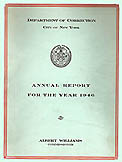
Peter F. Amoroso, M.D.
Commissioner
10/16/40 -- 12/27/46This three-page outline of NYC DOC history is attributed to the administration of Dr. Amoroso because it was prepared by his staff even though the name appearing on the title page for the 1946 annual report is that of his successor, Albert Williams.
Amoroso, in his 1941 annual report, had particularly mentioned that preparations were underway to chronicle NYC DOC history.
That history is summarized in the opening pages of the 1946 annual report submitted to Mayor William O'Dwyer by Albert Williams only five days after his having been named Commissioner.
Amoroso had resigned Dec. 27, 1946. The annual report, including the history, was sent to the mayor by Williams on Jan. 1, 1947. Clearly the work producing the report, including the historical outline, was carried out under Amoroso as Commissioner.
|
[This was, so far as known, the first attempt by NYC DOC
to set forth its history in one of its annual reports.
The account is extracted from the 1946 annual report.]HISTORY OF THE
DEPARTMENT OF CORRECTION
OF THE CITY OF NEW YORK
The Department of Correction grew from problems of the poor. Up to 1860 the workhouse and city prisons were in the almshouse department.
It was Chapter 510 of the Laws of 1860 which . . . established a Department of Public Charities and Correction. This, in turn, was divided into the separate departments of Charities and of Correction in 1896.
During the time of the Dutch Colonists there were two prisons: one in Fort Amsterdam which was used chiefly for the maintenance of military discipline and the punishment of refractory Indians; the other was in the Stadt Huys at the head of Coenties Slip. The latter building, erected in 1642, served as a tavern, court, city hall and prison.
The space set aside for prisoners was one small rear room on the first floor, opposite the whipping post arid stocks.
The first jail of the English Colonists was in the house of General Brincherhoff at Coenties Slip and Dock Street from 1692 to 1699. Apparently this was the same prison used by the Dutch.
After 1699 it was removed to the new City Hall. The basement of the new quarters was reserved for ordinary offenders, the sub-basement for dangerous characters, and the attic for debtors.
As the result of a law passed in 1756, a prison was built and completed in 1759. It was located on what was then called the "Commons" (now City Hall Park). This jail was used as a British military prison during the Revolution and was also known as Provost or Martyrs Prison; later it was called the Debtor's Prison. It was a four-story building. In 1830, it was reconstructed and fitted for public records and used as a Hall of Records until it was demolished in 1903
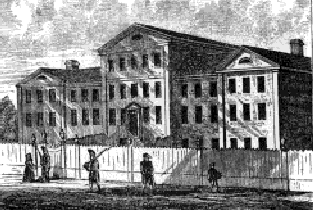 |
Bridewell, West Side, City Hall, 1806. |
The need for larger quarters resulted in the erection of the Bridewell in 1775. It served until 1838 -- the year it was abolished. This was built on the west side of City Hall opposite Broadway and Warren Street. In the nineteenth century this building was known as the Hall of Records. It furnished some of the stone for the Hall of Justice on Centre Street (the "Tombs").
Of interest to students of penology is the law of 1796 which established the first state prison in New York, in Greenwich Village. This law mitigated the extreme harshness of the penal code. For example: The use of capital punishment was restricted, prison sentences being prescribed for offenses hitherto punishable with death.
In fact, this law was a forerunner of the modern method which emphasized the correctional treatment of the criminal by imprisonment. This state prison was opened in 1797, sold to the City in 1826. The prisoners were removed to Sing Sing in 1829.
In 1816 a penitentiary for persons convicted of minor offenses was built on the East River Shore at Bellevue near the almshouse. In 1826 Bellevue Hospital was built, and the three buildings were surrounded by a stonewall.
About 1848 the penitentiary inmates were removed to Blackwell's Island (Welfare). The old Workhouse, later referred to as the Correction Hospital or Workhouse for Women, was built in 1852.
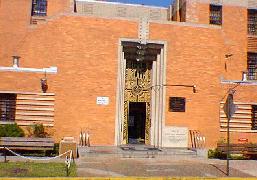 |
Rikers Island Penitentiary. |
The penitentiary with its century-old cells was abandoned and demolished in 1936. Outstanding symbol of the new day in the City's correctional system is the modern penitentiary on Rikers Island, opened in 1935. This is a ten million dollar institution.
The cornerstone of Raymond Street Jail in Brooklyn was laid in August 1836. The Kings County Penitentiary, located on Crown Street, Brooklyn, is said to have been occupied in January 1854. This institution was demolished about 1907; its prisoners, together with the machinery and manufacturing industries, were removed to the Penitentiary on Blackwell's Island.
The present City Prison Brooklyn was entirely remodeled into fire-proof construction in 1909. It was then considered the "most modern" of any of the prison buildings. The building known as the Annex was originally built as the Women's Prison.
It is charged with making proposals for long-range planning to the Mayor and Commissioner of Correction.
Prior to the consolidation of the City in 1898, the institution[s] in Kings, Queens and Richmond were under the sheriffs of those counties. This separate functioning of the institutions continued for some time after consolidation. The first to be turned over to the City was the City Prison Brooklyn which was transferred from the Sheriff of Kings County to the Department of Correction of New York City (Chapter 637 of the Laws of 1907). The prison was taken over officially on January 1, 1908.
The City Prison Queens was formerly the Queens County Jail, erected in 1895. By Chapter 456 of the Laws of 1912, this was transferred to the Department of Correction on June 1, 1912.
Bronx County was established by Chapter 548 of the Laws of 1912. The act originally provided that prisoners should be held in New York County Jail until such time "as the Sheriff will be satisfied by the jail or other place of detention to be hereafter erected by the County of the Bronx." Under this provision there was subsequently erected a Bronx County Jail, with a new one replacing it in l938.
In amendment to the Charter of the City of New York, after the elections of November 1941 provided that "any prisoners held for any cause in criminal proceedings shall be surrendered to the Department of Correction." Subsequently control of the City Prison Bronx and City Prison Richmond was turned over to the Department of Correction. It is important to note that until January 1, 1942 there had never been a fully unified Department of Correction for the City.
The original Tombs Prison was built at Centre Street in 1838. It was constructed with 148 double cells which, in accordance with the practice of that period, gave it a capacity for 296 prisoners. This existed until 1897. The second Tombs Prison was opened in 1902 and was the largest and busiest detention institution; it consisted of a main building and two annexes. This prison was connected by a "Bridge of Sighs" with the Criminal Courts Building on the Franklin Street side. This prison had a normal capacity of 591 cells; it was a massive stone structure with steel cells. The building was abandoned in 1941 when a new prison, known as the City Prison Manhattan, was occupied on Sunday, November 8, 1941.
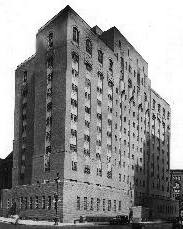 |
Women's House of Detention in Greenwich Village. |
It is located at 125 White Street, adjacent to and connected by two bridges to the New Criminal Courts Building at 100 Centre Street. It is interesting to note that on the very site of the present City Prison Manhattan stood the gallows, stocks, and other forms of torture, including public floggings, [that took in a much earlier era].
Women prisoners were transferred from the Penitentiary and Workhouse on Welfare Island to the House of Detention for Women at 10 Greenwich Avenue, Manhattan. This structure was opened in 1932 and every woman offender in the five counties of the City is held here awaiting trial. This institution serves as the workhouse for those women who have been convicted as misdemeanants. It also serves as the County Penitentiary for Women committed by the local courts. In addition, material witnesses are detained here.
Since there is no federal detention house for women in this locality, the federal department boards its women defendants awaiting trial at the House of Detention for Women.
The New York City Reformatory for misdemeanants was established by Chapter 305 of the Laws of 1905, with an amendment under Chapter 516 of the Laws of 1907, limiting commitments to first offenders.
This was established on Harts Island occupying the buildings that were formerly an old insane asylum.
The site for the present Reformatory in New Hampton, Orange County, New York, was acquired in 1913. The first boys were moved there on March 8, 1914. The young men sent there, all on indeterminate sentences, had training facilities in many fields.
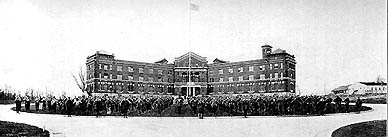 |
Daily Setting-Up Exercises, New York City Reformatory, New Hampton. |
When the Reformatory at New Hampton was completed in 1916, the Harts Island institution was then renamed "Reformatory Prison." The Department acquired Harts Island in 1868. Potters Field, which opened April 20, 1869, is located on this property.
The Department of Correction operates 41 separate places of detention for persons awaiting trial or disposition after trial, and for material witnesses.
These include small detention pens adjacent to the various Magistrates' Courts, Special Sessions Courts and Domestic Relations Courts [that] are in use only during the day. The guarding of the prison wards at Bellevue, Kings County and Fordham Hospitals was made a responsibility of the Department of Correction by the new City Charter in 1938.
Through the thirteen institutions operated by the Department with an average daily population of 3,915, there passes annually a heterogeneous horde of human beings. Their ages range from sixteen to ninety; their offenses from street begging and traffic violations to robbery and murder. They include the sick, the crippled, the feebleminded, and the insane. They also include vigorous, intelligent professional criminals of the most dangerous type. Their care and custody, as the Department's share in the City's work of law enforcement, involve a staff of twelve hundred employees; a headquarters organization with nine bureaus, and an annual budget of over four million dollars.
| 